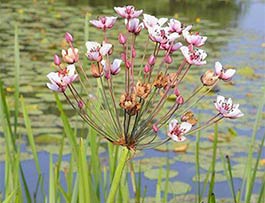Flowering Rush
Butomus umbellatus • Class A |
||
| Family Name: | Butomaceae family (BEW-toh may-see-ee) | |
| Common: | Grass Rush, Water Gladiolus | |
| Genus: | Butomus (BEW-toh-mus) Meaning: From Greek bous (ox) and tomos (cutting), referring to the sharp leaf margins | |
| Species: | umbellatus (um-bell-AY-tus) Meaning: in umbels - referring to the umbrella shaped flower clusters | |
| Description: |
An emergent, aquatic perennial, Flowering Rush is the sole species of the Butomaceae plant family. Plants grow from 1 to 5 feet tall, on cylindrical stalks topped by umbrella shaped clusters of 20 to 50 light pink flowers. Flowers have 3 large petals, 3 sepals, 9 stamens and pistils. Blooms from June to August. Its sword-like leaves grow from stout rhizomes, and may be submerged, floating or emerge from water.
|
| Why Is it a Noxious Weed? |
Flowering Rush is an invasive aquatic plant that competes with native wetland and shoreline species and can crowd out desirable vegetation. It is an aggressive colonizer, and difficult to control. |
| Where Does it Grow? |
Flowering Rush is found in freshwater habitats. It roots in the mud along lake shores, slow moving rivers, irrigation ditches, and wetlands. It typically grows in shallow waters, but can survive in water up to 9 feet deep. |
| Facts: |
Seeds and plant fragments are dispersed primarily by wind and water, but may also be spread by waterfowl, wildlife, or boating equipment. In addition to rhizomes and rhizome fragments, it reproduces by forming vegetative bulbils (little pea-sized bulb like sprouts) on the rhizomes and at the base of the flower stalk. Some, but not all, plants reproduce by seeds.
|
| Control Options: |
|
| More Information: |
For more information on this noxious weed Download our Flyer or visit Washington State Noxious Weed Control Board Here. Photos by Beki Shoemaker, Pierce County Noxious Weed Control Board.
|
| More Pictures: |






 Pierce County Noxious Weed Control Board • 9200 122nd St E, Puyallup, WA 98373 • 253-798-7263
Pierce County Noxious Weed Control Board • 9200 122nd St E, Puyallup, WA 98373 • 253-798-7263